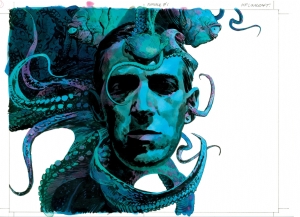Guest Blog by William Holloway. The Thing in the Basement – HP Lovecraft and Racism
 Being a worthy young man, it was an inevitability that you would come into your inheritance, as you hail from a historic family that traced it’s origins in New England all the way back to Roanoke. You receive a letter from an executor telling that your long lost uncle, a thin gaunt New England eccentric, has disappeared, leaving his estate in Providence to you. You’ve never met him, but your grandmother always said he looked just like you, he spoke just like you, before crossing herself and looking away. You had always chalked this up to mere superstition…
Being a worthy young man, it was an inevitability that you would come into your inheritance, as you hail from a historic family that traced it’s origins in New England all the way back to Roanoke. You receive a letter from an executor telling that your long lost uncle, a thin gaunt New England eccentric, has disappeared, leaving his estate in Providence to you. You’ve never met him, but your grandmother always said he looked just like you, he spoke just like you, before crossing herself and looking away. You had always chalked this up to mere superstition…
Ah, Providence! Both timely and temporal, of rain swept streets and fog enshrouded boulevards, gambrel roofed homes and witch haunted memory! You set out at once to inspect this new addition to your portfolio, and are instantly charmed by it. It feels like home, it feels like a part of you went missing and has been returned by an act of providence. The library is sumptuous, the tomes both byzantine and welcoming. You’ve only heard darkly veiled whispers of the the Necronomicon, Cultes Des Ghoules, De Vermiis Mystiris, The Incendium Malificarum, and Pecul Numeritor, having spent time as a professor of letters at Miskatonic University.
But now, all of this is yours, a whole world to explore.
It feels right. It feels like home.
But then…the horror in the basement! Aberrant, ruggose, a thing that should not be! It appears to be a column, but the angles are wrong. It is vulgar, unsightly, evocative of dark aeons best left forgotten to the sands of time. Why has such singular beauty been marred by such hideous blemish? What madness drove the former inhabitant, that thin gaunt New England eccentric, to force it where it need not be?
Yet the next day, the executor cables you with news of monumental import. The column, the heinous eidolon can be removed, and the the shadows and peaks of fog enshrouded Providence can once again dream beneath the black stars of infinity in something like peace.
What, you might ask, is our good narrator going on about?
Essentially, this column, this eidolon, this thing in the basement is not a load bearing structure. In fact it has nothing to do with the house other than that the builder put it there, seemingly out of spite for himself and everyone else. The thin gaunt New England eccentric is none other that HP Lovecraft, and you, the buyer are really reading one of his stories.
What then, you ask is this pillar, this eidolon of terrible angles and nameless meaning?
Well, it does have a name. That name is racism.
But the moral of this story, a story now being told by the reader to the author, is that this pillar is not essential to the story, this house shall not fall, but rather continue to dream its dreams into the minds of others for untold aeons.
HP, you say, “This racism has nothing to do with the story. We could just name the cat Bob. Those swarthy hordes in the Horror at Red Hook could just be anyone we currently find alien, exotic, threatening. or just plain suspect. Perhaps Furries? Perhaps suspicious types who dress up as colonial era philosophers and debate the rights of man in witch haunted Providence?”
So, HP asks, “This racism, as you call it, is not part of the essential nature of the thing?”
No, you answer, it is not.
Now that we’ve gone meta with our parable, we can discuss the real heart of the matter: The Lovecraft Problem. Howard Philips Lovecraft was a writer of no mean proportion, only what he did with that writing was a shame and a caution and an eldritch horror. He was a racist, a real racist. He believed, as many did at the time, that race was the primary determinant of individual and group characteristics. This is not subjective racism, that he was a racist is not in debate. No my dear readers, Lovecraft’s racism was real, actual racism.
To a man of today, it’s jarring. There you are reading this fascinating wordsmith and you come across it, and are launched out of an engrossing tale and straight into the fact of it. It’s racist. It really is.
But you keep reading, you shake your head, and you finish the story. That story was awesome, but that completely unnecessary addition well nigh ruined it. But you keep reading his stories anyways, in fact you read all of them. You become one of the cult, one of those people referred to as Lovecraftians. There’s one on every bus. They’ve got tentacle tattoos and funny taste in just about everything.
Then someone reads an article to you from a highbrow and sophisticated arbiter of nothing such as The New York Review of Constipated Snobbery. It says Lovecraft sucks. You ignore it until you hear that word. The R word. Racist.
You ask yourself; How did I do it? How did I file away that nasty nugget of truth about this man, how did I reconcile this?
It is here that your dear narrator must step in and make a confession. I really had to think about it. How exactly did I square this circle? And here, ladies and gentlemen is my answer: Lovecraft’s Racism is not essential to his prose, to his monsters, or to his universe. If you removed it, it’s essence would remain intact.
His monsters, his universe, were created by a a horrifying childhood and a terrible and precocious vulnerability. The swarthies in The Horror at Red Hook, the name of the cat in The Rats in the Walls, and a few other examples that slip my mind, are not why you read Lovecraft or why I read Lovecraft. As I said, you could engage in a bit of cut and paste and make those baddies from The Horror at Red Hook into Furries, hell you could turn them into Lovecraftians and the story would still work. Yes, Lovecraft’s intentions were racist. But the story itself doesn’t actually hinge on race.
The cat? Call him Bob and read on.
Is this dismissive? Yes, that’s the point. If you’re going to be a reader rooted in the present day, you can’t really read Lovecraft and not find some means to reconcile yourself with his racism. Granted, its harder with Lovecraft. His racism wasn’t merely the institutional racism of the day, it was especially bitter and spiteful.
How dare I say this isn’t important?
OK, you wanna watch me say it again? It isn’t important. He was a racist and he snuck it into his writing, but it isn’t essential to his writing, none of his stories hinge on race. Yes, there are people who analyze and interpret and have very important sounding titles, ironic glasses, and a turtleneck. They are professor blah blah of blah blah blah and they are here to make a fuss. In other words they are engaging in the time honored tradition of rent seeking. But ask yourself; what’s worse, you living with the fact that an author you like was also a racist or being a rent seeking twat? You liking a guy that was scared of his own shadow and consequently scared of everything else, or being one of the multitude currently preening and polishing their halos?
Are they shouting from the mountaintops that Mahatma Ghandi was a racist? Are they going to retire their Che Guevera shirts because he was a racist and a war criminal?
Somehow I doubt it.
In short, buy the old house in Providence. It’s got an ugly past and a gross thing in the basement, but you’ll survive with your sanity and soul intact. (maybe)
William Holloway is a horror novelist from the Great State of Texas. His first novella, aptly titled Death in Texas, was written in 1998 and correctly presaged the zombie apocalypse hysteria that swept the zeitgeist of the 2000’s. It has since been lost to time, but rumors of it’s existence abound.
More than a decade later he put pen to paper and began his cosmic horror series, titled The Singularity Cycle. The first novel was titled The Immortal Body and was self published in 2012. Not many people read it, but those that did saw something unseen in cosmic horror…
The Immortal Body, and it’s follow up, titled Song of the Death God, have been acquired by British Horror Maven Graeme Reynold’s Horrific Tales Publishing along with his standalone novel entitled Lucky’s Girl.
http://www.amazon.com/Luckys-Girl-William-Holloway-ebook/dp/B00MQ8YFL4/



I enjoy anything that has insight but still manages to keep a bit of wit about it! This piece does just that so well! There is insight here seriously done about an serious topic, but it doesn’t lose sight that things need to be taken as a whole and given some perspective of what is actually going on concerning the subject matter and Holloway’s commentary is delivered with the somberness such a topic seemingly deserves while always maintaining a readability about it!
One of the most incisive articles I’ve read on this subject. It seems that most people want to use Lovecraft and his racism as a political football or a source for their own self-aggrandizement, rather than having a serious and thoughtful discussion about it.
Well put. I also think its interesting how people assume Lovecraft’s racism was unleavened with self awareness.
When you read his letters, or memorials by those who knew him, when you consider the Great Escape Attempt when a virulently racist insular loner who these days would probably be diagnosed with a catalogue of obsessions and compulsions and borderline agoraphobia suddenly married a Jewish woman and moved to the bustling melting pot of races and cultures of New York City and started talking like an FDR progressive, it seems very clear that Lovecraft KNEW that he was a fucked up mess of a human being and made an absolutely stunning attempt for someone like him to change everything. It was brave, it was admirable.
It couldn’t last. The contradictions piled up, his marriage collapsed and he retreated back into the shell of his aunt’s house in Providence and the comfortable disgust and terror of pathological xenophobia.
I feel pity for a man who TRIED to become something and someone other than who he was. And failed.
Reblogged this on The Site That Should Not Be.